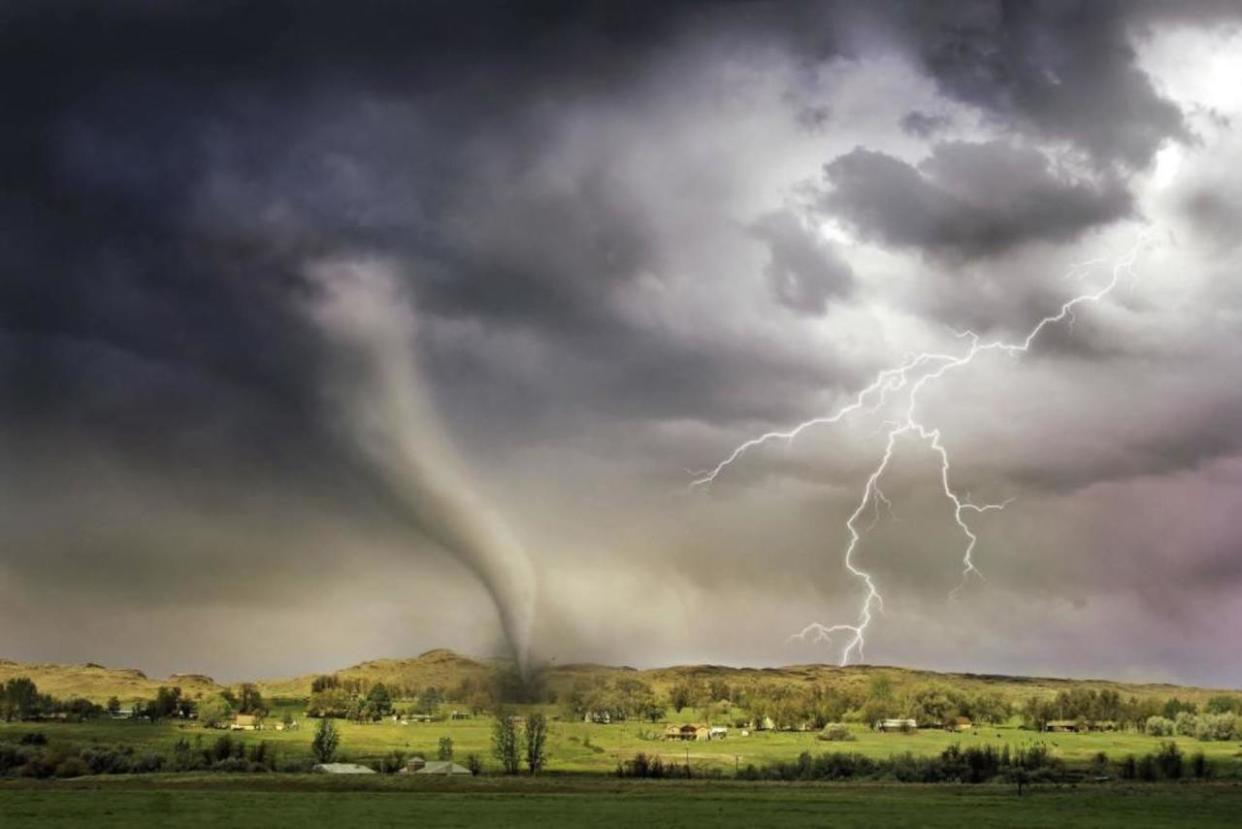Passion for Weather: What fuels our meteorologists

For the people who work each day to bring Canadians their weather, it starts and stops with passion.
And if you ask each of the professionals who pore over layers of data to sift out the details and clues that ensure a correct and trustworthy forecast, the passion began at a young age, and for most, with a distinct weather event.
Here are their stories.
Erin Wenckstern, Meteorologist
Dayna Vettese, Meteorologist
Michael Carter, Meteorologist
Tyler Hamilton, Meteorologist
Chris Murphy, Weather Personality, Meteorologist
Jaclyn Whittal, Weather Personality, Meteorologist
1.When did the passion for weather awaken for you?
JW: When I went through a snow squall event in 2007 in Muskoka, we were completely snowed in at our house in Bracebridge, ON. This event brought up to 176 cm of snow, we had just built a home there and it looked like a home in "Whoville" from The Grinch Who Stole Christmas when it was all done!
TH: My passion for weather became evident when I was 8 or 9. I distinctly remember gazing outside at street lights trying to spot precipitation changing to snow, and not being able to sleep while waiting for a rare snowstorm or the common windstorm off the Pacific Ocean. This probably drove my parents crazy.
CM: I have been fishing since I was 3 years old and use to spend a couple of weeks each summer at one cottage or another with my family growing up.
Watching thunderstorms - especially night ones that were impossible to sleep through - became a source of family time up north in particular.
We (mom, dad and three sisters) would count the seconds between the lightning, which would cascade across the lake, and the thunder.
If the time between the lightning and thunder grew smaller, the storm was coming towards us, and if the time separation between the two got bigger, the storm was moving away.
Hearing and feeling the wind howl through the screened in front porch (when there was one) added to the excitement and fear we all felt huddled together during the tempest.
2. How did the passion first manifest itself?
EW: For many years, it was simply a fascination. I would, oddly enough, watch The Weather Network or any documentary that came on that involved weather. My fifth grade science project was on tornadoes and how they form, for which I built an extremely high-tech tornado from water and a large pop bottle.
However, it wasn't until my final year in high school that I thought of pursuing meteorology as a career. I was having a lot of difficulty deciding what type of program I wanted to apply for in university. It ranged from dance to computer science. My mother told me, "Well, you're going to be working for the majority of your life, so try and think of something you find fascinating and try to make a career out of it." It just so happened this conversation was during a major thunderstorm, so from there on, it was obvious to me that I'd apply for a degree in Atmospheric Science.
MC: I followed the weather closely when I was young, watching TV weather reports every night and eventually learning to use the more comprehensive sources of weather data on the internet. When the time came for me to choose my course of study at university, it would already have been an easy choice - but when I saw a presentation from the meteorology department’s storm chasing team that sealed the deal.
DV: As I got older, and the fear was still there, I started watching The Weather Network religiously, especially in the summer, to check the forecast to see if there were storms on the way. The more I watched, the less fear I had as I started to feel “prepared” for the storms coming and I started to learn. As I entered high school, the childhood fear transformed into a love of weather, an obsession, and I decided that’s where I wanted my career path to take me: meteorology.

File photo of a weather observer
3. What piece of technology do you love using the most in order to tell the weather stories?
EW: There is nothing better than satellite imagery, particularly, visible. It shows you the big picture and how dynamic our atmosphere is. Of course, forecasters wouldn't be what they are today without weather models, so I would say that's a close second.
TH: My favourite piece of technology has evolved with technological advancements throughout my time studying and interacting with weather. Here’s a sample of my favourite technology over time:
1998: The Weather Network, mercury outdoor thermometer, Environment Canada weather hotline
2001: Personal weather station, online weather forecasts, and digital outdoor thermometer
2004-2008: Webcams
2012-2013: Twitter, WeatherBell, blogs e. Current: TWN Baron weather graphics system (3D products), twitter & social media, satellite imagery
4. Where do you see meteorology in 10 years? What will change?
MC: Though the fundamentals of the atmosphere are a constant, meteorology is a fast-moving science, and things have changed dramatically in the 10 years that I’ve been active in the field. I would only expect these changes to accelerate in the coming 10 years - from advances in computer modeling that will aid forecast accuracy, to more and better observation systems such as satellite platforms and sensor networks. New tools and technologies will allow us to do our jobs better, and communicate our forecasts in more ways.
EW: I see meteorology as a growing science; however, it comes with many unavoidable limitations. It's important for the public to know the inherent errors that come with trying to accurately model the atmosphere. The fact is, our thin atmosphere is so complex and the smallest change can cause massive ripples in a forecast. Regardless of how powerful technology becomes, physics will never allow us to have an atmosphere that's completely predictable.
That being said, quantum computing is where the future of meteorology lies. Weather models require some of the most powerful computers in the world to perform their calculations. The codes within these models are forced to make crude generalizations to reduce their computation time; otherwise, they would take too long to produce a forecast, rendering them useless. But with the sheer power of a quantum computer, which can simultaneously solve multiple problems at a time -- compared to computers today, which solve one problem at a time -- this wouldn't be an issue. While a fully functioning quantum computer is still a ways away, there is exciting progress as scientists have recently produced and managed quantum entanglement, a feat that must be met to create a quantum computer. When the quantum computer, the future of computing, arrives, so does the next era in Meteorology.
JW: I see our long range forecasting abilities only getting more refined. I believe we will do to more daily weather balloon launches, that increase in data will help to improve model performance and that will make things even more accurate. I also see the RADAR capabilities improving with more developments, making storm chasing even more successful and fun!
CM: When I was completing my final year at Mississippi State University for my Broadcast and Operations Meteorology Degree and I found some of the courses frustrating.
By that I mean, there was very little to do with climate change [at the time] and the evolving technology we had at our disposal. As technology advances and our knowledge of how to keep up with Mother Nature, or rather in our attempts to stay at no more than one step behind, I am still sitting through lectures that are 20 years old and reading textbooks that were printed in the 1960s and painstakingly solving math equations that computers now do for us.
Climate change is a game changer. While it is nothing new, the rate at which it is occurring does appear unprecedented aside from an actual meteor striking the earth and bringing instant change worldwide.
Despite our best guesses, we don't really know what will happen - we can only give educated guesses that change over time, from dire to not so dire depending on who you believe. On the positive side, what we know about weather in general today is miles ahead of what we used to know. For example, we still don't know which exact cloud a tornado will form, but the lead time in warning the public that one may occur in a specific area has grown dramatically, thus saving lives. Spotting and tracking hurricanes has improved to the point where we can see these massive storms in their most infant stages, thousands of miles away.
Accuracy in weather forecasts now are as good three days out as they used to be one day out.
In the age of instant info via social media, we now have access to images of storms we never had before, everyone is a potential a storm chaser. This however may be both a good and not so good turn of events.
The professionals are providing us with images, location and lead time to get the message out instantly. Those however, who do not have the experience to deal with one of Mother Nature's turns, are putting themselves and others at risk.
TH: In 10 years, people will be digesting weather information in a very instantaneous way–where clarification, personalization, and ease of accessing the information will be key. Weather alerts and severe weather forecasting will continue to become more accurate giving more lead-time to the public for active weather. Meteorologists will continue to be the primary liaison to the public to disseminate the technical computer model simulations and break down the threats and technical aspects of the weather models. Currently, automated products fail to convey uncertainty/risk. These products still provide only a primitive level of detail. Human instinct and judgement will continue to be paramount in creating accurate weather forecasts into the future.
DV: Meteorology has already changed so much in the last 10 years and will continue to do so. High resolution weather models will continue to improve which will improve accuracy, lead time, and give meteorologists more tools to forecast. From a weather communications standpoint, the damage for “instant weather” will continue to grow. Our culture has come to expect information instantaneously through the Internet, smart phones, and social media so I see weather communication becoming much more instant.
--


